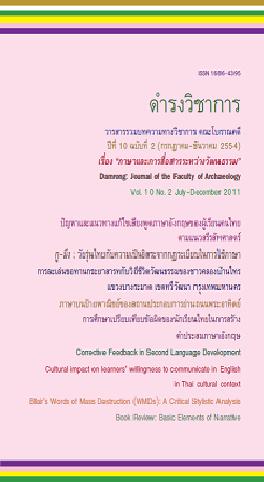KU AND MUNG: THAI TEENAGERS AND INDEPENDENCE FROM PRESRIPTIVE LANGUAGE USAGE
Keywords:
ภาษาไทย, การพูด, วัยรุ่นไทย, การสื่อสารAbstract
The language used by Thai teenagers nowadays reflects their need to be independent from rules and regulations prescribed in grammar books. As far as pronouns are concerned, ku and mung are stigmatized as being “impolite” without any further explanation. Teenagers want to communicate quickly, to activate group solidarity and to help each other when trouble arises. Outsiders may judge the language they use within the group or among themselves as “rough” or “impolite”. Teenagers, on the other hand, do not consider the language they use as impolite. For teenagers, the language they use within their groups is a language of solidarity. It is more important and meaningful to them than politeness.
References
กรมศิลปากร. เสภาเรื่องขุนช้างขุนแผน. กรุงเทพฯ: แพร่พิทยา. 2513.
กาญจนา นาคสกุล และคณะ. การใช้ภาษา. กรุงเทพฯ: เคล็ดไทย. 2521.
ธำรงศักดิ์ เพชรเลิศอานันท์. ร.ม.ว. คึกฤกษ์ ปราโมช นายกรัฐมนตรี. ศิลปวัฒนธรรมฉบับพิเศษ. 2546.
พุทธทาสภิกขุ. คู่มือปฏิบัติอานาปานสติสมบูรณ์แบบ. กรุงเทพฯ: ธรรมทานมูลนิธิ 2530.
ราชบัณฑิตยสภา. พจนานุกรมฉบับราชบัณฑิตยสถาน. กรุงเทพฯ: นานมีบุ๊คส์. 2542.
อิราวดี ไตลังคะ. ศาสตร์และศิลป์การเล่าเรื่อง. กรุงเทพฯ: มหาวิทยาลัยเกษตรศาสตร์. 2543.
Noss, Richard B. Thai Reference Grammar. Washington, D.C.: Foreign ServiceInstitute, 1964.
Smyth, David. Thai: An Essential Grammar. New York: Routledge. 2002. Wardhaugh, Ronald. An Introduction to Linguistics. New York: Basil Blackwell. 1986.
Downloads
Issue
Section
License
บทความนี้เป็นผลงานของข้าพเจ้าแต่เพียงผู้เดียว และ/หรือเป็นผลงานของข้าพเจ้าและผู้ร่วมงาน ตามชื่อที่ระบุในบทความจริง และเป็นผลงานที่มิได้ถูกนำเสนอหรือตีพิมพ์ที่ใดมาก่อน





